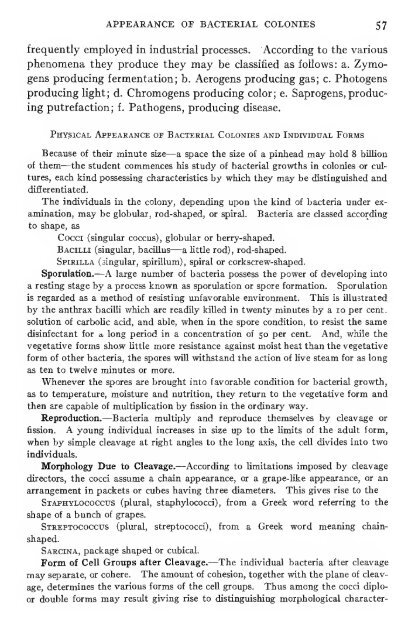Pharmaceutical botany - Lighthouse Survival Blog
Pharmaceutical botany - Lighthouse Survival Blog
Pharmaceutical botany - Lighthouse Survival Blog
Create successful ePaper yourself
Turn your PDF publications into a flip-book with our unique Google optimized e-Paper software.
APPEARANCE OF BACTERIAL COLONIES 57<br />
frequently employed in industrial processes. According to the various<br />
phenomena they produce they may be classified as follows: a. Zymo-<br />
gens producing fermentation; b. Aerogens producing gas; c. Photogens<br />
producing light; d. Chromogens producing color; e. Saprogens, produc-<br />
ing putrefaction; f. Pathogens, producing disease.<br />
Physical Appearance of Bacterial Colonies and Individual Forms<br />
Because of their minute size—a space the size of a pinhead may hold 8 billion<br />
of them—the student commences his study of bacterial growths in colonies or cultures,<br />
each kind possessing characteristics by which they may be distinguished and<br />
differentiated.<br />
The individuals in the colony, depending upon the kind of bacteria under ex-<br />
amination, may be globular, rod-shaped, or spiral. Bacteria are classed according<br />
to shape, as<br />
Cocci (singular coccus), globular or berry-shaped.<br />
Bacilli (singular, bacillus—a httle rod), rod-shaped.<br />
Spirilla (singular, spirillum), spiral or corkscrew-shaped.<br />
Sporulation.—A large number of bacteria possess the power of developing into<br />
a resting stage by a process known as sporulation or spore formation. Sporulation<br />
is regarded as a method of resisting unfavorable environment. This is Ulustrated<br />
by the anthrax bacilli which are readily killed in twenty minutes by a lo per cent,<br />
solution of carbolic acid, and able, when in the spore condition, to resist the same<br />
disinfectant for a long period in a concentration of 50 per cent. And, while the<br />
vegetative forms show little more resistance against moist heat than the vegetative<br />
form of other bacteria, the spores will withstand the action of hve steam for as long<br />
as ten to twelve minutes or more.<br />
Whenever the spores are brought into favorable condition for bacterial growth,<br />
as to temperature, moisture and nutrition, they return to the vegetative form and<br />
then are capable of multiplication by fission in the ordinary way.<br />
Reproduction.—Bacteria multiply and reproduce themselves by cleavage or<br />
fission. A young individual increases in size up to the limits of the adult form,<br />
when by simple cleavage at right angles to the long axis, the cell divides into two<br />
individuals.<br />
Morphology Due to Cleavage.—According to limitations imposed by cleavage<br />
directors, the cocci assume a chain appearance, or a grape-like appearance, or an<br />
arrangement in packets or cubes having three diameters. This gives rise to the<br />
Staphylococcus (plural, staphylococci), from a Greek word referring to the<br />
shape of a bunch of grapes.<br />
Streptococcus (plural, streptococci), from a Greek word meaning chain-<br />
shaped.<br />
Sarcina, package shaped or cubical.<br />
Form of Cell Groups after Cleavage.-—The individual bacteria after cleavage<br />
may separate, or cohere. The amount of cohesion, together with the plane of cleav-<br />
age, determines the various forms of the cell groups. Thus among the cocci diplo-<br />
or double forms may result giving rise to distinguishing morphological character-
















